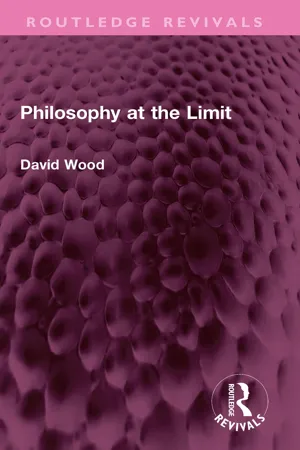
- 178 pages
- English
- ePUB (mobile friendly)
- Available on iOS & Android
Philosophy at the Limit
About this book
First published in 1990, Philosophy at the Limit was originally part of the Problems of Modern European Thought book series. It pursues the theme of philosophy's confrontation with its own limits, in modern philosophers from Hegel to Derrida, including Nietzsche, Wittgenstein, Heidegger, and Gadamer. The author focuses on questions of philosophical style, dialogue and indirect communication, the structural closure of philosophical texts, and performative strategy in philosophy. The book is an accessible discussion of many of the complex issues that empower continental philosophy. It will appeal to students of philosophy and contemporary thought at every level, and to the general reader interested in the heart of the debates in European thought.
Frequently asked questions
- Essential is ideal for learners and professionals who enjoy exploring a wide range of subjects. Access the Essential Library with 800,000+ trusted titles and best-sellers across business, personal growth, and the humanities. Includes unlimited reading time and Standard Read Aloud voice.
- Complete: Perfect for advanced learners and researchers needing full, unrestricted access. Unlock 1.4M+ books across hundreds of subjects, including academic and specialized titles. The Complete Plan also includes advanced features like Premium Read Aloud and Research Assistant.
Please note we cannot support devices running on iOS 13 and Android 7 or earlier. Learn more about using the app.
Information
Table of contents
- Cover
- Half Title
- Title Page
- Copyright Page
- Original Title Page
- Original Copyright Page
- Table of Contents
- Editors’ foreword
- Acknowledgements
- Introduction
- 1 The faces of silence
- 2 Metaphysics and metaphor
- 3 Deconstruction and criticism
- 4 Philosophy as writing: the case of Hegel
- 5 Nietzsche’s styles
- 6 Indirect communication
- 7 Vigilance and interruption: Derrida, Gadamer and the limits of dialogue
- 8 Performative reflexivity
- Conclusion: the theatre of difficulty
- Index